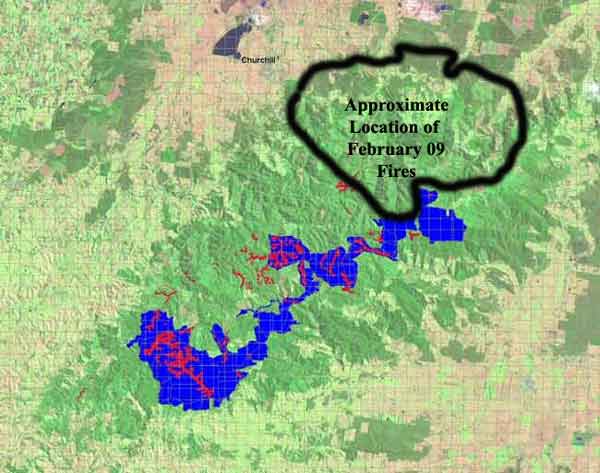

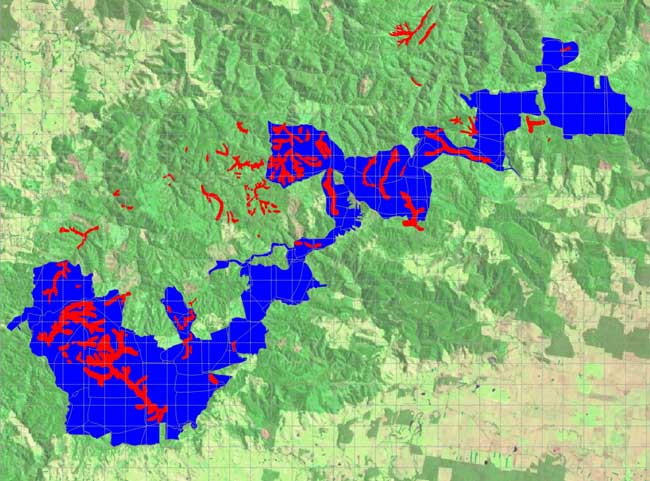
The original cores and links, with rainforest marked in red
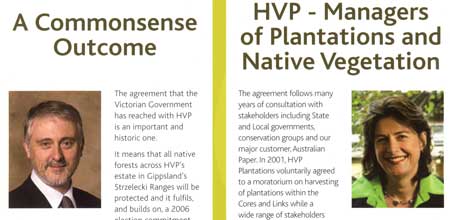
August 2008: Lacklustre PR spin from publicly available leaflet produced by Hancock to convince the public that the deal is a winner. Gavan Jennings, Victorian CONservation Minister and Linda Sewell, CEO Hancock Victorian Plantations forever linked together in what possibly could spell the ruin of much of the Strzelecki Rainforest. Only a few months after Jennings became CONservation Minister, his Department of Sustainability and Environment Secretary signed off on Hancock's Rainforest Best Management Practices (October 31 2007), which basically endorsed gutting key rainforest catchments in the Strzeleckis with minimal buffers. This came at a crucial time in the negotiations over the Cores and Links and fully supported Hancock's corporate logging agenda.

Also in the leaflet were interesting comments attributed to Mike Gooey Executive Director of the Trust for Nature (above). Gooey sounds extremely excited about this new proposal which will effectively see destruction of sites and National Conservation Significance. Gooey appeared lukewarm (some say totally disinterested) about the 2006 Heads of Agreement which protected rainforest areas such as College Creek and gifted the Cores and Links to TFN. Why would he be so happy about the new deal that could well lead to the destruction of most of the remaining rainforest in the Strzelecki Ranges whilst at the same time leaving no role for the Trust for Nature?
The Leaflet says "The Victorian Government is committed to the Trust for Nature (TFN) having a role in the areas that return to public ownership after the one-off harvest by HVP. Trust for Nature is ready to respond.
The Trust for Nature responded strongly to the Minister's statement, welcoming the agreement. Trust for Nature's executive director Mike Gooey said: 'This exciting development heralds a new mature working relationship between government, business and not-for-profit organisations'. 'We congratulate the Government on exceeding the 2006 election commitment to protect the Cores & Links and surrounds. This announcement ensures that, with Trust for Nature's help, the native forests in the Strzelecki Ranges will be protected forever' Mr Gooey said.
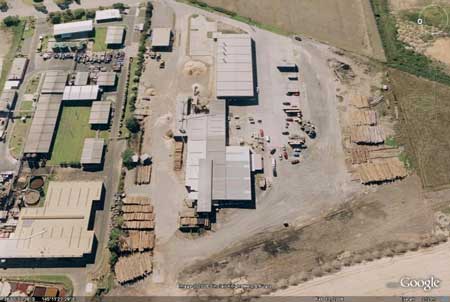
10% of all logs from the Strzelecki Cores and Links Rainforest Reserve end up at Dormit Pty Ltd Ordish Road Dandenong. Dormit is probably the largest hardwood sawmiller in Gavan Jennings South Eastern Metropolitan Upper House Region. Dormit would be the third largest hardwood timber buyer from the Strzeleckis after Paperlinx (75%) and Drouin West Sawmills (~10%).
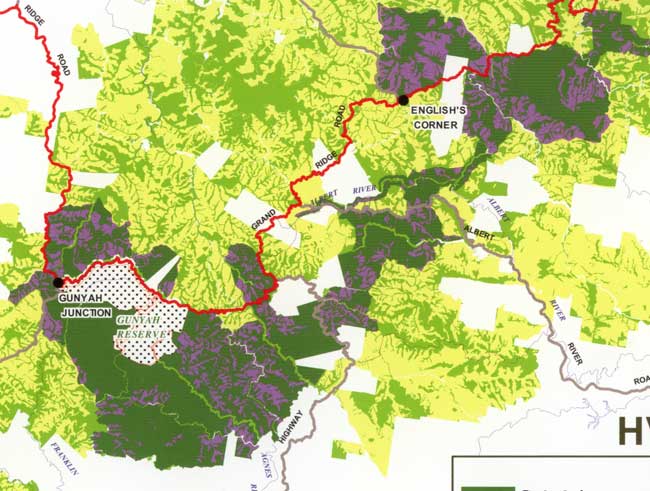
Where has all the rainforest gone? Bit of an oversight don't you think? The map publicly provided by Hancock outlining the cores and links deal to members of the public. Note that no mention of rainforest is mentioned on this map, even though the Cores and Links was originally set up to protect rainforest. This blatant oversight is what CONseration Minister Gavan Jennings calls "A Commonsense Outcome".
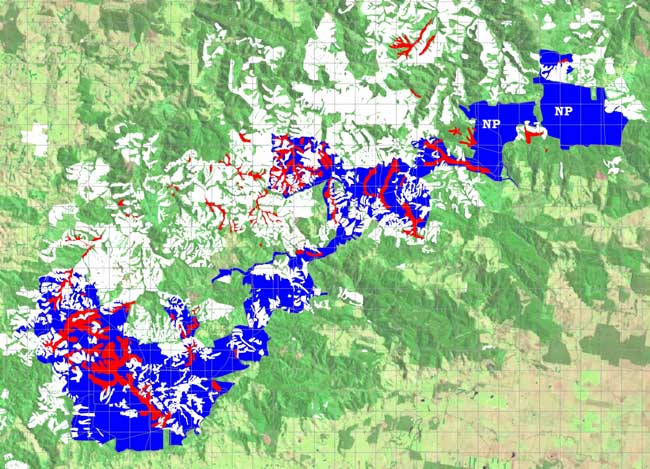
Operations of Hancock Victorian Plantations in the Strzelecki Ranges
As a founding member of the Strzelecki Forest Community Group I was nominated to negotiate on behalf of the community along with Anne Westwood the Trust For Nature's Manager for West Gippsland, to deal with matters relating to a Heads of Agreement ( HOA) which was signed by the State Government, the Trust for Nature , the Stzelecki Forest Community Group- comprising three shires, the West Gippsland Catchment Management Authority, the Trust for Nature, community groups and HVP/GRP and Australian Paper, in October 2006.
The information contained in this booklet is nothing more than a public relations exercise and contains many claims which can not be substantiated. I would like to provide you with a history of what has become known as the Cores and Links Rainforest Reserve and the community's resolve to redress the ecological and social imbalances in the Strzelecki Bioregion which has occurred due decades of bad policies and land management decisions.
Formation of the Strzelecki Working Group

DSE document July 6 2006
Community concern about the sale of the Victorian Plantations Corporation in 1998 ( the Strzelecki Public Forests) to Hancock Timber Resource Group in the US, without community consultation led to the formation of the Strzelecki Working Group (SWG) in 1999. This group comprising Latrobe, Wellington & South Gippsland shires, the West Gippsland Catchment Management Authority (WGCMA) , Hancock Victorian Plantations Pty Ltd (HVP) and its subsidiary Grand Ridge Plantations (GRP) the Trust For Nature (TFN in 2000) along with environmental and community groups, engaged Biosis Research Pty. Ltd. to assess the conservation values of HVP holdings in the Strzelecki Ranges. (The Strzelecki Ranges Biodiversity Study. Biosis Research. November 2001).
The purpose of the study was to identify areas of high biodiversity value and develop management options for protecting these values. Five core areas and associated habitat links were identified as focal points for biodiversity and included areas of Cool Temperate Rainforest and populations of rare, threatened and endangered flora and fauna, which are vulnerable to disturbances.
The areas were identified as: Merriman's Core Area linking Tarra Bulga National Park to South Middle Creek on the Tarra River to Jack River and College Creek Core areas joining the Albert River and Ryton link to Gunyah Gunyah Rainforest Reserve. These are all sites of National State and Regional conservation significance.
In all other circumstances these areas of leased crown land would have been set aside in protected parks/reserves decades ago. These are all high conservation value forests.
However in the Strzelecki Bioregion the driving force behind all timber policies has been dictated by the Paper Mill and the Timber Industry at the expense of all other ecological and social factors.
Failure to protect the Biodiversity values of the Strzelecki Ranges
Government policy and legislation has failed to protect the ecological assets of this region.Strzelecki public forests have been treated differently to all other public forests in the state.
(Refer to attachment "Land Conservation Council -Review of Victorian Plantations Corporation Vested Lands As requested by the Minister for Planning, August 1993".)
The Victorian Plantation Corporation acquired State Forest areas, prior to government commitment to the Gippsland Regional Forest Agreement. This means that the Strzelecki Ranges were excluded from protection under the Comprehensive Adequate and Representative Reserve System (CAR). Presently, only 2% of the Strzelecki Ranges are protected within reserves or parks.
The minimum area for public forests is 15% representation of the original vegetation cover. This represents thousands of hectares protected in other public forests in Victoria.


May 15 2006 DSE documents showing that DSE and Hancock already had established a three option strategy regarding the cores and links. This plan was 'hatched' in front of community negotiators for the first time on May 18 2006 at a meeting with the Chief of Staff of the Conservation Minister. This shows that DSE and Hancock were already colluding about the deal without anyone from the community being involved. At the May 18 meeting DSE/DPI were supporting the logging of controversial areas of the Cores and Links, providing a reduced Cores and Links map (Hancock's agenda) to back up their claims. The community was immediately put on the defensive. It was also clear that the DSE/DPI negotiators appeared surprised when informed that the map provided at the meeting showed a greatly reduced Cores and Links Rainforest Reserve than what the community had been lobbying for.
Memorandum of Understanding (MOU's)
HVP/GRP entered into an agreement with the Community and Trust for Nature by signing a Memorandum of Understanding with the Trust for Nature and the Nature Conservancy in 2004. When the Company removed itself from this MOU another Agreement was signed with the State Government, the Community the Trust for Nature and Australian Paper in October 2006. This agreement is referred to as the Heads of Agreement (HoA).
The HoA was to provide an opportunity for HVP to meet its contractual arrangement to the Maryvale Mill with a "one off harvest" (until the volume of 600,000 cubic metres pulp was reached), of designated areas within the Cores and Links.
Access to Custodial land
Rather than further fragmenting an area which was already compromised due to decades of land mismanagement it was agreed that if there was a shortfall after the "one off harvest" in the areas in the Cores and Links, a small amount would have to be accessed from Custodial land. These would be carefully selected sites from islotes, outlyers and areas within plantations.
The amount to be accessed from Custodial land was to be validated after audits of the volumes being accessed from each coupe, were determined. The company presented the 460,000 cubic metres figure, it was never accepted by the community and had not been validated by any audits.
The HoA detailed the process whereby the best biodiversity outcome would be delivered linking Tarra Bulga National Park to the Gunyah Gunyah Rainforest Reserve . This agreement provided a degree of transparency and accountabilty with full community consultation at every level of the process.
The Trust For Nature a Statutory Authority was to manage the project which would eventually deliver a world class Rainforest Reserve.
The HoA delivered sub-catchment and partial sub-catchment to the Core areas of Rainforest to ensure their long term viability.
The major stakeholders involved in all of these agreements was the Strzelecki Forest Community Group, (the SWG minus the Industry) who networked widely with many other groups within their communities.

DSE document 24 August 2006 showing Hancock's preferred option at this time was to log 400,000m3 of pulp from their own native forest (custodial land). This agenda would have wiped out ~1000+ha of native forest, as well as logging large sections of the cores and links. This was way above (900ha more) than what the community were initially pushing for.
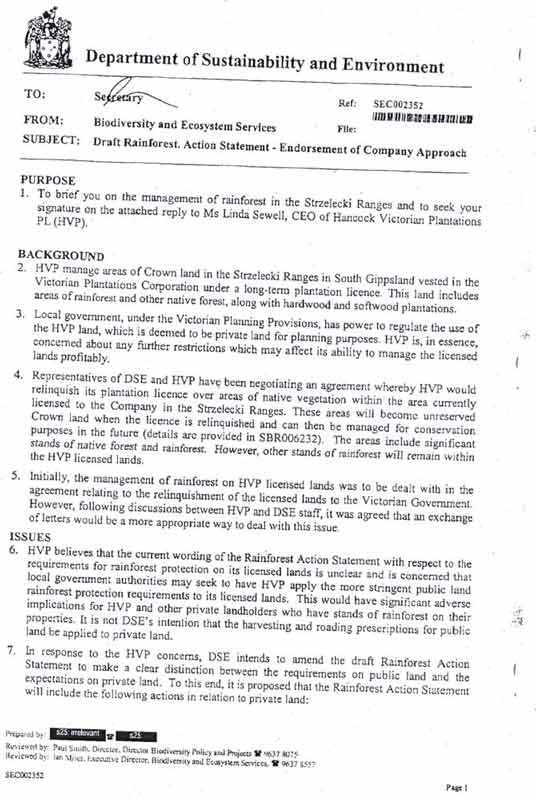

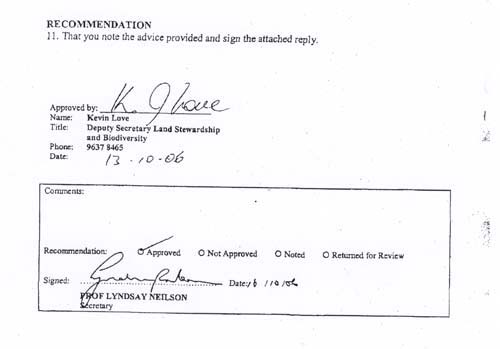
DSE document signed on the exact day that Minister John Thwaites announced the Cores and Links Reserve by key DSE negotiator Kevin Love.
Breach of Trust
On the 30th May 2008 the community was informed via a media release that the past 10 years of negotiations between the company and the community through the Strzelecki Forest Community Group had been abandoned by the company and the government for a "secret agreement" whereby the Core Areas of Rainforest which had been given total protection under the HoA would now be harvested.
Custodial land to be protected under this "secret" deal: land which is identified by the company as non plantation areas- according to the map ( scale of 1:50.0000 ) released to the Public, 50% of the area includes weed infested gullies, riparian zones in Pine and Shining Gum plantations, areas which contain little merchantible timber and is varied in quality & size and is often isolated pockets not connected to other corridors of native bush. The exception being a few areas adjacent to Tarra Bulga National park.
The new deal is a distraction from the major issue, saving the Core Areas of Strzelecki Cool Temperate Rainforest by leaving intact buffers of wet forests connecting existing parks and reserves thereby providing a healthy viable reserve system. This deal has no similarities to anything that the major stakeholders have discussed over the last 10 years and therefore should not be referred to as the Cores and Links Reserve.
This is the 3rd time that this company and its predecessor AMCOR/ APP has refused to deliver commitments made to the community and statutory authorities.
Friends of Gippsland Bush are waiting for the company to deliver 12,000 hectares of Nature Reserves promised to the people of Gippsland in the "8 point" agreement signed between FOGB and APP in 1997. Sites of National significance such as the Darlimurla Block are not included in this New Deal.
HVP removed themselves from the MOU signed with the Trust for Nature and Nature Conservancy in 2004 claiming that their modeling was incorrect and a failure of 1100 hectares of Blue Gum would lead to a shortfall of 600,000 cubic metres of pulp for the Mill.
Failure to meet commitments made in the HoA

DSE document April 30 2007 showing shortfall increased after the HoA was signed in October 2006. This was the key factor behind the deal falling through.
The figure of 600,000 cubic metres was the only shortfall figure ever presented at Public Meetings from 2005-2006. The Company informed all parties post signing the HoA that the shortfall was over 835,000 cubic metres and that this did not include the sawlog component ( nothing to do with the shortfall of pulp to the Mill) which would increase the volume over 1,000,000 cubic metres.
The Company also claimed that none of the shortfall would come from the designated harvest areas in the Cores and Links, agreed upon areas as per the HoA , but it would all come from Custodial land.
Needless to say the community and the Minister of the day Minister John Thwaites rejected these outrageous company demands.
In 2008 without consultation with the stakeholders involved in negotiations which led to the signing of the HoA, the company removed itself from the process. We were informed by a media release.
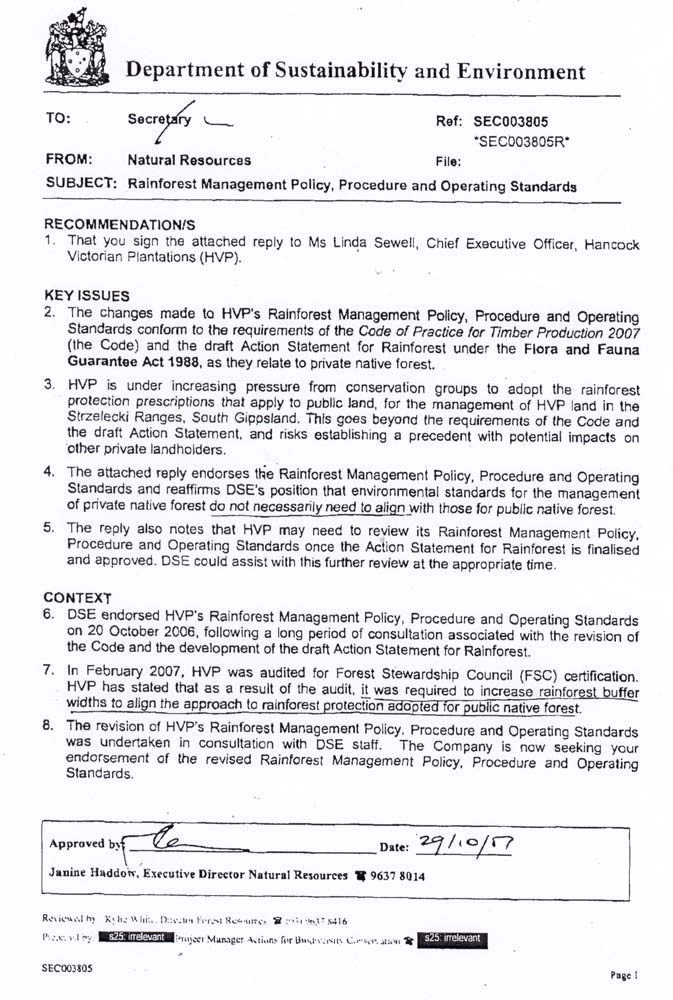
Interesting admission that policies for rainforest on private land do not necessarily have to align with those of public land. Why?
The New agreement
A harvest of 1500 hectares within in the Cores and Links will totally compromise the integrity of the sites containing the highest biodiversity values in the Strzelecki Bioregion.
It has the potential to destroy all of the remnant Cool Temperate Rainforest and much of the fauna including the only endemic Koala in Victoria and South Australia.
HVP harvests native forests and plantations please refer to attachment
"Land Conservation Council -Review of Victorian Plantations Corporation Vested Lands As requested by the Minister for Planning, August 1993" Extract.
Biosis Research Pty. Ltd. April 2005 Report to Latrobe City Page 7
Inadequate Protection of Rainforest
HVP have redefined Rainforest -which has no scientific basis and ignores all scientific reviews and recommendations. One example ĺ of the Rainforest of College Creek has been removed from HVP operational maps this is replicated across the estate.
Therefore a claim that HVP is protecting Rainforest in the Cores and Links becomes meaningless
A technical review of HVP's Rainforest Management Practices Peer Review of Proposed Rainforest Best Management Practice Walshe and Cameron October 20051 states
"In particular we regard the treatment of risks posed by weed invasion, buffer disturbance and edge effects, Myrtle Wilt and wildfire to be deficient." "In the context of Principle 9 of FSC Interim Standard protection measures for Nationally, State and Regionally significant rainforest are inadequate."
The review notes that one Company goal suggests the objective of "no net loss" may be traded-off or compromised by commercial considerations. It states: "Protection measures will be tailored according to the conservation significance of each patch of rainforest and the impact on investment value of adjoining plantations".
A trade-off with commercial interests is again implied in the BMP Rationale, where it is asserted that, "the overall degree of protection provided to Rainforest across company land is a value judgement designed to balance investment outcomes with conservation of environmental values. The company is best placed to make a responsible judgement."
You do not have to harvest rainforest to destroy it. Removal of adequate protection substantail buffers or subcatchment protection will ensure its demise. Definitions applying to State Forests are NOT applicable to the Strzelecki Forests as we do not major sites of National and State significance protected in extensive parks and reserves as is the case in Public Forests.
Table of comparison in booklet
There is no comparison in terms of biodiversity outcomes between this "secret" arrangement and the Cores and Links Rainforest Reserve.
I have describe in the text above that much of the area set aside, outside of the Cores and Links hold little biodiversity value.
The new deal does not alter the fact that HVP harvest a combination of native forest which has regenerated and plantations on a daily basis, including stands of mixed forest prime Koala feed.
We are still waiting for a Koala Management Plan as we witness the destruction of koala feed and habitat.
College Creek is a site of National Conservation significance. It contains many endangered, rare and threatened species including Cool Temperate Rainforest and Powerful Owls. It is the stronghold on mainland Australia for the critically endangered Slender forked fern. It is a site of historic, cultural and scientific significance.
Like all other sites on Crown land in the Strzeleckis the planted part of the estate serves the same function as the original forest and is critical in protecting the Core Areas of Rainforest identified in the Strzelecki Biodiversity Study 2001and linking corridors to ensure safe fauna movement.
It is also a mix of regenerating forest and plantations which will all be clearfelled during harvest operations, refer to attachment.
There is NO safe way of harvesting this site that is why it was afforded subcatchment protection under the HoA signed by all parties.
The Forest Stewardship Council (FSC)
Friends of Gippsland Bush and FoE have been involved in the FSC process since its introduction into Australia in 2001. Our organisations have been involved in all of the Smartwood and Accrediting Services International (ASI) 2007, audits of the HVP estate since 2002.
There are many outstanding issues that Smartwood the certifiers and HVP have to meet in order to retain their certification status.
The Accreditation Services International (ASI) has undertaken an assessment of Smartwood's Audit process and HVP' certification status. FSC Surveillance of Smartwood for 2007 Forest Management Audit to HVP Pty.Ltd. 12-19 February 2007
The report states that there are major deficiencies in Smartwoods decision making system for issuing and maintaining certificates. page 20
HVP displays continous non- compliance with relevant standard requirements page 11
Page 9 "ASI auditor considers that there has been ongoing non-compliance with some of the FSC requirements since 2002 with regard to the transparency of the certification process and stakeholder consultation process as well as environmental and high conservation value forest issues."
Susie Zent (Friends of Gippsland Bush) November 2008

With friends like Wilderness Society and VNPA who needs enemies. What a sell out!
Then after supporting destruction of sites of national significance for 27 months, the same organisations turn around and say it was a bad deal afterall!
VNPA, TWS position on logging in the Strzelecki Ranges (August 12 2010)
The VNPA and The Wilderness Society do not support the logging of high conservation forests in Victoria including the Strzelecki ranges. While we initially welcomed announcements by the state government in May 2008, to protect 20,000 ha and return 8000ha to public control in the Strzeleckiís we do not support the allowance of logging of 1500 ha of the proposed reserve area, particularly the areas of high conservation significance such as College Creek and rainforest areas.
We believe many areas proposed for logging are of high conservation value and contain significant national and state listed species. We support the view of respected Ecologists Stephen Mueck, was quoted in 2008 as saying ďThe forests that are there today very closely resemble the natural ash forests in other parts of the state. Ecologically, youíd look at these plantations and you canít tell the difference between them and a native forest.
ď[Itís] a political and/or an economic decision. Itís not an ecological one. The core areas arenít being protected in the way in which it was contemplated, and so, in an ecological context, I donít think thatís a good result.Ē
Matt Ruchel The Victorian National Parks Association
Luke Chamberlain Executive Director Victorian Forest Campaigner The Wilderness Society Vic Inc.